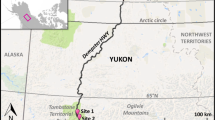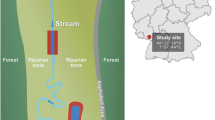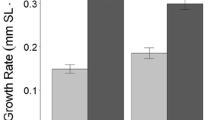Abstract
Numerous studies have found that predators can suppress prey densities and thereby impact important ecosystem processes such as plant productivity and decomposition. However, prey suppression by spiders can be highly variable. Unlike predators that feed on prey within a single energy channel, spiders often consume prey from asynchronous energy channels, such as grazing (live plant) and epigeic (soil surface) channels. Spiders undergo few life cycle changes and thus appear to be ideally suited to link energy channels, but ontogenetic diet shifts in spiders have received little attention. For example, spider use of different food channels may be highly specialized in different life stages and thus a species may be a multichannel omnivore only when we consider all life stages. Using stable isotopes, we investigated whether wolf spider (Pardosa littoralis, henceforth Pardosa) prey consumption is driven by changes in spider size. Small spiders obtained > 80% of their prey from the epigeic channel, whereas larger spiders used grazing and epigeic prey almost equally. Changes in prey consumption were not driven by changes in prey density, but by changes in prey use by different spider size classes. Thus, because the population size structure of Pardosa changes dramatically over the growing season, changes in spider size may have important implications for the strength of trophic cascades. Our research demonstrates that life history can be an important component of predator diet, which may in turn affect community- and ecosystem-level processes.




Similar content being viewed by others
Data availability
Data are available from the Dryad Digital Repository: https://doi.org/10.5061/dryad.jq2bvq868.
References
Agnew AM, Shull DH, Buchsbaum R (2003) Growth of a salt marsh invertebrate on several species of marsh grass detritus. Biol Bull 205:238–239
Bartos M (2011) Partial dietary separation between coexisting cohorts of Yllenus arenarius (Araneae: Salticidae). J Arachnol 39:230–235
Birkhofer K, Wise DH, Scheu S (2008) Subsidy from the detrital food web, but not microhabitat complexity, affects the role of generalist predators in an aboveground herbivore food web. Oikos 117:494–500
Bressendorff BB, Toft S (2011) Dome-shaped functional response induced by nutrient imbalance of the prey. Biol Lett 7:517–520
Buddle CM, Walker SE, Rypstra AL (2003) Cannibalism and density-dependent mortality in the wolf spider Pardosa milvina (Araneae: Lycosidae). Can J Zool 81:1293–1297
DeBach P, Rosen D (1991) Biological control by natural enemies. Cambridge University Press, Cambridge
DeNiro MJ, Epstein S (1981) Influence of diet on the distribution of nitrogen isotopes in animals. Geochim Cosmochim Acta 45:341–351
Denno RF (1977) Comparison of the assemblages of sap-feeding insects (Homoptera-Hemiptera) inhabiting two structurally different salt marsh grasses in the genus Spartina. Environ Entomol 6:359–372
Denno RF et al (2000) Feeding-induced changes in plant quality mediate interspecific competition between sap-feeding herbivores. Ecology 81:1814–1827
Denno RF, Gratton C, Peterson MA, Langellotto GA, Finke DL, Huberty A (2002) Bottom-up forces mediate natural-enemy impact in a phytophagous insect community. Ecology 83:1443–1458
Denno RF, Gratton C, Dobel H, Finke DL (2003) Predation risk affects relative strength of top-down and bottom-up impacts on insect herbivores. Ecology 84:1032–1044
Dobel HG, Denno RF, Coddington JA (1990) Spider (Aranae) community structure in an intertidal salt marsh: effects of vegetation structure and tidal flooding. Environ Entomol 19:1356–1370
Finke DL, Denno RF (2002) Intraguild predation diminished in complex-structured vegetation: implications for prey suppression. Ecology 83:643–652
Finke DL, Denno RF (2003) Intraguild predation relaxes natural enemy impacts on herbivore populations. Ecol Entomol 28:67–73
Finke DL, Denno RF (2004) Predator diversity dampens trophic cascades. Nature 429:407–410
Finke DL, Denno RF (2005) Predator diversity and the functioning of ecosystems: the role of intraguild predation in dampening trophic cascades. Ecol Lett 8:1299–1306
Finke DL, Snyder WE (2010) Conserving the benefits of predator diversity. Biol Conserv 143:2260–2269
Folz HC, Wilder SM, Persons MH, Rypstra AL (2006) Effects of predation risk on vertical habitat use and foraging of Pardosa milvina. Ethology 112:1152–1158
Fry B (2006) Stable isotope ecology. Springer Science, New York
Gratton C, Denno RF (2003) Inter-year carryover effects of a nutrient pulse on Spartina plants, herbivores, and natural enemies. Ecology 84:2692–2707
Griesinger P, Bauer T (1990) Predation and visual space in Saldula saltatoria (Linnaeus, 1758) (Heteroptera, Saldidae). Zool Anz 225:20–36
Halaj J, Wise DH (2002) Impact of a detrital subsidy on trophic cascades in a terrestrial grazing food web. Ecology 83:3141–3151
Hlivko JT, Rypstra AL (2003) Spiders reduce herbivory: nonlethal effects of spiders on the consumption of soybean leaves by beetle pests. Ann Entomol Soc Am 96:914–919
Hogg BN, Daane KM (2015) Cascading effects of cannibalism in a top predator. Ecol Entomol 40:805–813
Huseynov EF (2006) The prey of the lynx spider Oxyopes globifer (Araneae, Oxyopidae) associated with a semidesert dwarf shrub in Azerbaijan. J Arachnol 34:422–426
Langellotto GA, Denno RF (2006) Refuge from cannibalism in complex-structured habitats: implications for the accumulation of invertebrate predators. Ecol Entomol 31:575–581
Leroux SJ, Loreau M (2010) Consumer-mediated recycling and cascading trophic interactions. Ecology 91:2162–2171
Lopez GR, Levinton JS, Slobodkin LB (1977) The effect of grazing by the detritivore Orchestia grillus on Spartina litter and its associated microbial community. Oecologia 30:111–127
Mayntz D, Raubenheimer D, Salomon M, Toft S, Simpson SJ (2005) Nutrient-specific foraging in invertebrate predators. Science 307:111–113
Mellbrand K, Hamback PA (2010) Coastal niches for terrestrial predators: a stable isotope study. Can J Zool 88:1077–1085
Miller TEX, Rudolf VHW (2011) Thinking inside the box: community-level consequences of stage-structured populations. Trends Ecol Evol 26:457–466
Murphy SM, Wimp GM, Lewis D, Denno RF (2012) Nutrient presses and pulses differentially impact plants, herbivores, detritivores and their natural enemies. PLoS ONE 7:e43929
Newsome SD, Martinez del Rio C, Bearhop S, Phillips DL (2007) A niche for isotopic ecology. Front Ecol Environ 5:429–436
Oelbermann K, Scheu S (2002) Stable isotope enrichment (δ15N and δ13C) in a generalist predator (Pardosa lugubris, Araneae : Lycosidae): effects of prey quality. Oecologia 130:337–344
Oelbermann K, Langel R, Scheu S (2008) Utilization of prey from the decomposer system by generalist predators of grassland. Oecologia 155:605–617
Perkins MJ, Inger R, Bearhop S, Sanders D (2018) Multichannel feeding by spider functional groups is driven by feeding strategies and resource availability. Oikos 127:23–33
Persons MH, Rypstra AL (2001) Wolf spiders show graded antipredator behavior in the presence of chemical cues from different sized predators. J Chem Ecol 27:2493–2504
Phillips DL, Gregg JW (2001) Uncertainty in source partitioning using stable isotopes. Oecologia 127:171–179
Polis GA, Strong DR (1996) Food web complexity and community dynamics. Am Nat 147:813–846
Post DA (2002) Using stable isotopes to estimate trophic position: models, methods, and assumptions. Ecology 83:703–718
Preisser EL, Bolnick DI, Benard MF (2005) Scared to death? The effects of intimidation and consumption in predator-prey interactions. Ecology 86:501–509
Rickers S, Scheu S (2005) Cannibalism in Pardosa palustris (Araneae, Lycosidae): effects of alternative prey, habitat structure, and density. Basic Appl Ecol 6:471–478
Rooney N, McCann K, Gellner G, Moore JC (2006) Structural asymmetry and the stability of diverse food webs. Nature 442:265–269
Rudolf VHW (2006) The influence of size-specific indirect interactions in predator-prey systems. Ecology 87:362–371
Rudolf VHW (2007) Consequences of stage-structured predators: Cannibalism, behavioral effects, and trophic cascades. Ecology 88:2991–3003
Rypstra AL, Marshall SD (2005) Augmentation of soil detritus affects the spider community and herbivory in a soybean agroecosystem. Entomol Exp Appl 116:149–157
Rypstra AL, Carter PE, Balfour RA, Marshall SD (1999) Architectural features of agricultural habitats and their impact on the spider inhabitants. J Arachnol 27:371–377
Rypstra AL, Schmidt JM, Reif BD, DeVito J, Persons MH (2007) Tradeoffs involved in site selection and foraging in a wolf spider: effects of substrate structure and predation risk. Oikos 116:853–863
SAS (2002) SAS version 9.2. SAS Institute Inc., Cary
Samu F, Toft S, Kiss B (1999) Factors influencing cannibalism in the wolf spider Pardosa agrestis (Araneae, Lycosidae). Behav Ecol Sociobiol 45:349–354
Sanders D, Schaefer M, Platner C, Griffiths GJK (2011) Intraguild interactions among generalist predator functional groups drive impact on herbivore and decomposer prey. Oikos 120:418–426
Scharf FS, Juanes F, Rountree RA (2000) Predator size-prey size relationships of marine fish predators: interspecific variation and effects of ontogeny and body size on trophic-niche breadth. Mar Ecol Prog Ser 208:229–248
Settle WH et al (1996) Managing tropical rice pests through conservation of generalist natural enemies and alternative prey. Ecology 77:1975–1988
Shimazaki A, Miyashita T (2005) Variable dependence on detrital and grazing food webs by generalist predators: aerial insects and web spiders. Ecography 28:485–494
Sitvarin MI, Rypstra AL, Harwood JD (2016) Linking the green and brown worlds through nonconsumptive predator effects. Oikos 125:1057–1068
Snyder WE, Wise DH (2001) Contrasting trophic cascades generated by a community of generalist predators. Ecology 82:1571–1583
Sunderland K (1999) Mechanisms underlying the effects of spiders on pest populations. J Arachnol 27:308–316
Takizawa T, Snyder WE (2011) Predator biodiversity increases the survivorship of juvenile predators. Oecologia 166:723–730
Toscano BJ, Griffen BD (2012) Predatory crab size diversity and bivalve consumption in oyster reefs. Mar Ecol Prog Ser 445:65–74
Tscharntke T et al (2008) Conservation biological control and enemy diversity on a landscape scale. Biol Control 45:238–253
Van Raalte CD, Valiela I, Teal JM (1976) Production of epibenthic salt marsh algae: light and nutrient limitation. Limnol Oceanogr 21:862–872
von Berg K, Thies C, Tscharntke T (2010) Changes in herbivore control in arable fields by detrital subsidies depend on predator species and vary in space. Oecologia 163:1033–1042
Ward CL, McCann KS, Rooney N (2015) HSS revisited: multi-channel processes mediate trophic control across a productivity gradient. Ecol Lett 18:1190–1197
Wimp GM et al (2013) Predator hunting mode influences patterns of prey use from grazing and epigeic food webs. Oecologia 171:505–515
Wimp GM, Ries L, Lewis D, Murphy SM (2019) Habitat edge responses of generalist predators is predicted by prey and structural resources. Ecology 100:e02662
Wise DH (2006) Cannibalism, food limitation, intraspecific competition and the regulation of spider populations. Annu Rev Entomol 51:441–465
Wise DH, Snyder WE, Tuntibunpakul P, Halaj J (1999) Spiders in decomposition food webs of agroecosystems: theory and evidence. J Arachnol 27:363–370
Wise DH, Moldenhauer DM, Halaj J (2006) Using stable isotopes to reveal shifts in prey consumption by generalist predators. Ecol Appl 16:865–876
Wolkovich EM, Allesina S, Cottingham KL, Moore JC, Sandin SA, de Mazancourt C (2014) Linking the green and brown worlds: the prevalence and effect of multichannel feeding in food webs. Ecology 95:3376–3386
Zimmer M, Pennings SC, Buck TL, Carefoot TH (2004) Marsh litter and detritivores: a closer look at redundancy. Estuaries 27:753–769
Acknowledgements
Ken Able at the Rutgers University Marine Station facilitated our research at the Tuckerton field site. We thank M. Brabson, M. Douglas, B. Herb, D. McCaskill, and L. Power for their help in the field. We thank A. Adams, S. Apgar, K. Barker, M. Barker, E. Barnes, G. Connor, K. Grenis, C. Hallagan, B. Herb, K. Loewy, M. Lynch, J. McCarty, B. Rojewski, A. Styer, and S. Wu for helping in processing the samples in the lab. We thank E. Horna Lowell, C. Hallagan, and J. Wilson for their helpful comments on an earlier version of this manuscript. This research was supported by the National Science Foundation (NSF-DEB 1026067 to GMW; NSF-DEB 1026000 to SMM).
Author information
Authors and Affiliations
Contributions
All authors conceived the ideas, designed methodology, and collected the data. DL performed the statistical analyses. SM and GW led the writing of the manuscript; all authors contributed critically to the drafts and gave final approval for publication.
Corresponding author
Ethics declarations
Conflict of interest
The authors declare no conflicts of interest.
Additional information
Communicated by Liliane Ruess.
Electronic supplementary material
Below is the link to the electronic supplementary material.
Rights and permissions
About this article
Cite this article
Murphy, S.M., Lewis, D. & Wimp, G.M. Predator population size structure alters consumption of prey from epigeic and grazing food webs. Oecologia 192, 791–799 (2020). https://doi.org/10.1007/s00442-020-04619-7
Received:
Accepted:
Published:
Issue Date:
DOI: https://doi.org/10.1007/s00442-020-04619-7




